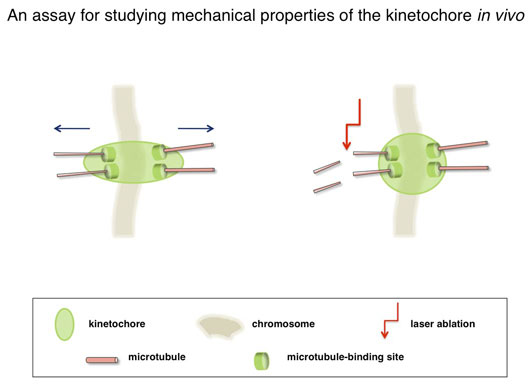Knowledge of the mechanical properties of the kinetochore is important for our understanding of how cells ensure faithful segregation of genetic information during cell division. In this study, we establish anaphase merotelic kinetochores as an experimental model for studying the mechanical response of the kinetochore in live cells. Our analysis performed in yeast and mammalian cells reveals both distinctive and evolutionarily conserved mechanical behavior of the kinetochore.

When a cell divides, it must ensure that each daughter cell receives one copy of each chromosome. Accurate chromosome segregation depends on proper attachment of kinetochores to microtubules. Mounting evidence suggests that the mechanical properties of the kinetochore are important for faithful segregation of chromosomes. Merotelic kinetochore orientation, a major cause of aneuploidy, is an error in which a single kinetochore binds microtubules emanating from opposite poles. We established merotelic kinetochores as an experimental system to study the mechanical properties of the kinetochore in live cells. By tracking the change in kinetochore size after laser-assisted microtubule severing, we were able to infer the mechanical properties of the kinetochore. In both mammalian PtK1 cells and in the fission yeast Schizosaccharomyces pombe, kinetochores shortened after microtubule severing with dynamics typical of viscoelastic materials. Interestingly, the inner kinetochore/centromere relaxed faster than the outer kinetochore. Whereas in fission yeast all kinetochores relaxed to a similar length, in PtK1 cells the more stretched kinetochores remained more stretched. Simple models suggest that these differences arise because the mechanical structure of the mammalian kinetochore is more complex.
Our ultimate aim will be to integrate the general principles of biochemistry, physics, and mechanics and build a comprehensive framework of kinetochore function.
Reference
Laser microsurgery reveals conserved viscoelastic behavior of the kinetochore. Cojoc G, Roscioli E, Zhang L, García-Ulloa A, Shah JV, Berns MW, Pavin N, Cimini D, Tolić IM, Gregan J. J Cell Biol. 2016; 212(7):767-76. doi: 10.1083/jcb.201506011. PMID: 27002163.


































